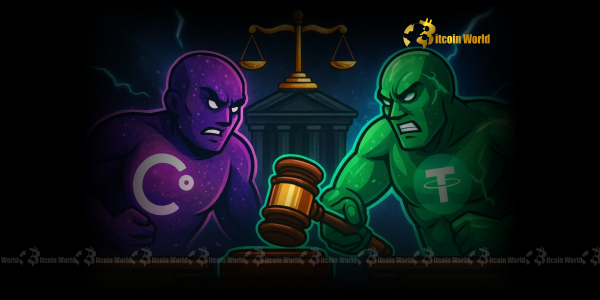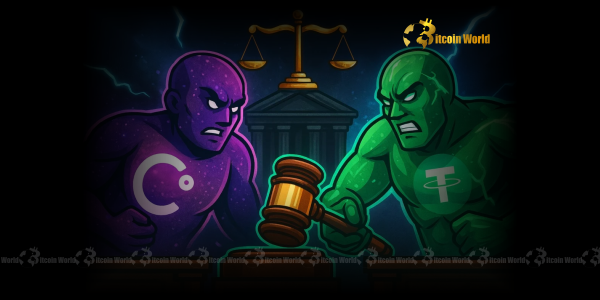BitcoinWorld

Celsius Lawsuit: Judge Unleashes Crucial Legal Battle Against Tether Over $4 Billion Bitcoin Liquidation
The cryptocurrency world is once again captivated by a high-stakes legal drama, as a U.S. bankruptcy judge has given the green light for bankrupt crypto lender Celsius to proceed with its lawsuit against Tether. This ruling marks a significant development in a case that could reshape how the crypto industry views asset management, liquidation practices, and contractual agreements. At the heart of this dispute are allegations of improper liquidation of a staggering 39,500 BTC, valued at approximately $4 billion, during Celsius’s tumultuous collapse in 2022. This isn’t just about money; it’s about setting precedents in a nascent yet rapidly maturing financial landscape.
The Genesis of the Celsius Lawsuit: A Shocking Allegation
The saga began when Celsius, once a prominent name in crypto lending, filed for Chapter 11 bankruptcy in July 2022. This move sent shockwaves through the market, freezing billions in user funds and leaving countless investors in limbo. As part of its efforts to recover assets for creditors, Celsius’s legal team turned its attention to Tether, the issuer of the world’s largest stablecoin, USDT. The core of the Celsius lawsuit revolves around claims that Tether engaged in questionable practices during a period of extreme market volatility, specifically concerning a substantial Bitcoin holding.
Celsius alleges that Tether’s actions constituted a breach of contract and a fraudulent transfer under U.S. bankruptcy law. The sheer scale of the alleged liquidation—39,500 BTC—highlights the immense financial implications of this case. For context, this amount of Bitcoin represents a significant portion of Celsius’s total assets at the time of its downfall, making its recovery crucial for creditors hoping to reclaim their funds. This legal action underscores the complex interdependencies within the crypto ecosystem and the often-unclear contractual frameworks that governed relationships between major players during the bull market.
Unpacking the Controversial Tether Liquidation
What exactly happened during the alleged Tether liquidation? Celsius claims that Tether, acting as a counterparty, liquidated a substantial amount of Bitcoin collateral held by Celsius at unfavorable terms or in a manner that violated their existing agreements. While the exact details of the contract between Celsius and Tether remain under wraps, Celsius’s legal filings suggest that Tether’s actions were not in line with the agreed-upon terms, particularly concerning the timing and method of liquidation. This is not merely a dispute over price; it delves into the fundamental principles of contract law and the duty of parties to act in good faith, especially when dealing with distressed assets.
The allegations of ‘fraudulent transfer’ are particularly severe. In bankruptcy law, a fraudulent transfer typically refers to a transfer of assets made by a debtor with the intent to defraud creditors or a transfer made for less than reasonable value while the debtor was insolvent. If proven, this would imply that Tether gained an unfair advantage at the expense of Celsius’s creditors. This claim suggests a deliberate action rather than simply a market-driven liquidation, elevating the stakes considerably for both parties involved. The court’s decision to allow these claims to proceed indicates that Celsius has presented a plausible argument that warrants further investigation.
Navigating the Labyrinth of Crypto Bankruptcy
The Celsius case is one of several high-profile examples of crypto bankruptcy that have emerged from the 2022 market downturn, alongside collapses like FTX and Three Arrows Capital. These cases have exposed significant vulnerabilities in the crypto industry, particularly regarding asset segregation, transparency, and consumer protection. Unlike traditional financial bankruptcies, crypto bankruptcies often involve novel legal questions concerning the nature of digital assets, the jurisdiction over decentralized entities, and the enforceability of smart contracts.
For Celsius, the lawsuit against Tether is a critical component of its broader strategy to maximize asset recovery for its creditors. The success or failure of this claim could significantly impact the eventual payout for those who had funds locked on the platform. The challenges in navigating crypto bankruptcy are immense, ranging from identifying and tracing digital assets across various blockchains to dealing with international jurisdictions and the sheer complexity of crypto financial products. This lawsuit, therefore, is not just about Tether; it’s a test case for how courts will handle similar disputes in the future, providing much-needed clarity in a murky legal landscape.
A Pivotal Bitcoin Legal Battle: What’s at Stake?
This unfolding legal confrontation represents a pivotal Bitcoin legal battle, not just for the parties directly involved, but for the entire cryptocurrency industry. With $4 billion in Bitcoin on the line, the financial stakes are astronomical. For Tether, a loss could result in a significant financial penalty and, perhaps more damaging, a blow to its reputation as a reliable stablecoin issuer. The integrity and stability of stablecoins are paramount to the broader crypto market, and any perceived impropriety could erode investor trust.
Beyond the immediate financial consequences, the outcome of this lawsuit could set a powerful precedent for how liquidations are conducted in the crypto space, particularly during periods of market stress. It could force crypto firms to adopt more transparent and clearly defined liquidation policies, ensuring fair treatment for all parties. Furthermore, it highlights the growing trend of legal and regulatory scrutiny on major crypto players, pushing the industry towards greater accountability and compliance. This battle underscores that even in the decentralized world, traditional legal principles will ultimately apply.
The Authority of the US Bankruptcy Court
A crucial aspect of this development is the ruling by the US bankruptcy court. Tether had filed a motion to dismiss the lawsuit, arguing, among other things, a lack of U.S. jurisdiction and that Celsius’s claims were not legally sufficient. However, the judge rejected key parts of Tether’s motion, finding that there were sufficient U.S. ties to establish jurisdiction and that Celsius’s claims of breach of contract and fraudulent transfer were plausible enough to proceed to discovery and potentially trial.
This decision is a testament to the increasing willingness of U.S. courts to assert jurisdiction over global crypto entities when there are clear connections to U.S. financial systems or investors. It signals that simply operating in a decentralized manner or from offshore locations does not automatically shield companies from U.S. legal oversight, especially when U.S. investors or bankruptcy proceedings are involved. The court’s ruling sends a clear message: allegations of significant financial misconduct in the crypto space will be thoroughly examined under existing legal frameworks.
What Are the Core Claims Against Tether?
Celsius’s lawsuit against Tether primarily rests on two key allegations:
- Breach of Contract: Celsius alleges that Tether violated the terms of their agreement concerning the management and liquidation of the Bitcoin collateral. This could involve issues related to notice periods, liquidation prices, or the process by which the assets were handled.
- Fraudulent Transfer: This is a more serious claim, suggesting that the transfer of Bitcoin from Celsius to Tether was made with an intent to defraud creditors or was conducted for less than fair market value at a time when Celsius was insolvent. If proven, this could lead to the recovery of the transferred assets for the benefit of Celsius’s creditors.
Why Did Tether’s Dismissal Attempt Fail?
Tether’s motion to dismiss was based on several arguments, including a lack of personal jurisdiction and the insufficiency of Celsius’s claims. However, the court found:
- Sufficient U.S. Ties: The judge determined that Tether had enough operational and financial connections to the U.S. to warrant jurisdiction, allowing the case to proceed in a U.S. court.
- Plausible Claims: The court concluded that Celsius had presented enough factual allegations to make its claims of breach of contract and fraudulent transfer plausible, meaning they weren’t frivolous and deserved to be litigated further.
What Does This Mean for Celsius Creditors?
For the thousands of Celsius creditors, this ruling offers a glimmer of hope. While it doesn’t guarantee a recovery, it opens a significant avenue for potentially increasing the pool of assets available for distribution. A successful outcome for Celsius in this lawsuit could add billions to the bankruptcy estate, significantly improving the prospects for creditors to recoup a larger portion of their lost funds. However, legal battles are often long and costly, and the road to resolution remains challenging.
The Broader Impact on the Crypto Ecosystem
This lawsuit is more than just a dispute between two companies; it has far-reaching implications for the entire crypto ecosystem:
- Increased Scrutiny: It highlights the growing regulatory and legal scrutiny on major crypto players, especially those involved in lending, stablecoins, and asset management.
- Importance of Clear Contracts: The case underscores the critical need for robust, legally sound, and transparent contractual agreements between crypto entities, particularly when dealing with large sums of collateral.
- Risk Management: It serves as a stark reminder for both institutional investors and individual users about the inherent risks in the crypto market, emphasizing the importance of due diligence and understanding the terms of service with any platform.
- Precedent Setting: The outcome could set a significant legal precedent for how future disputes involving crypto liquidations and alleged fraudulent transfers are handled in U.S. courts.
The journey ahead for the Celsius lawsuit against Tether promises to be a captivating and complex one. As the legal proceedings unfold, the crypto community will be watching closely, understanding that the implications extend far beyond the immediate parties. This case is a critical step in defining the legal boundaries and responsibilities within the digital asset space, pushing for greater accountability and clarity in an industry that continues to evolve at breakneck speed. It’s a testament to the fact that even in the decentralized world, the rule of law ultimately prevails.
To learn more about the latest crypto market trends, explore our article on key developments shaping Bitcoin price action.
This post Celsius Lawsuit: Judge Unleashes Crucial Legal Battle Against Tether Over $4 Billion Bitcoin Liquidation first appeared on BitcoinWorld and is written by Editorial Team





